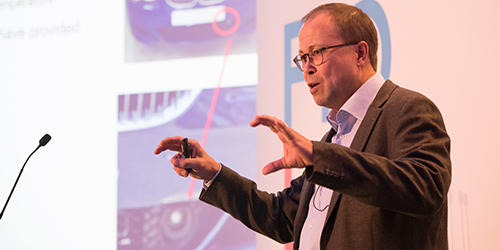From Night Vision to LIDAR: An Automotive Perspective
by Nala Rogers

LIDAR may soon provide drivers with new, clear views of what's coming down the road. But for the engineers developing this technology, the road to success is still full of hidden hazards. In the first visionary lecture of the OSA 2018 meeting, Jan-Erik Källhammer drew on his own hard-won success with automotive night vision technology to offer tips and predictions for automotive LIDAR developers.
As a researcher with the automotive safety supplier Autoliv AB and its electronics spinoff company Veoneer, Källhammer led the development of a long wave infrared night vision system now found in cars by Audi, BMW, Cadillac, Mercedes and Peugeot.
To show what this system can do, Källhammer played a split-screen video of the road unfolding before a moving car at night. In the normal driver's-eye view, the sides of the road were obscured in darkness; in the night vision version, the scene brightened to reveal a bicyclist with a dog.
Such technology has obvious potential to improve safety, both for traditional and autonomous vehicles. But to get it to market, Källhammer's team faced diverse challenges, from export license policies to gusts of hot air blowing back on the sensor from the engine.
Some of the challenges only cropped up once the cars entered real-world circulation. For example, Källhammer told the story of night vision vehicles owned by wealthy youths in the Persian Gulf, a land racked by violent sandstorms.
"They realized that long wave infrared can see through sand, so they were doing racing in sandstorms," said Källhammer. The sandblasting treatment broke the sensors, leading to warrantee claims and a redesign.
Other challenges came from fitting night vision devices into the larger system of car production, said Källhammer. For example, an earlier version took too long to install and held up assembly lines -- a fatal flaw in the auto industry.
Car safety technology is a field with great potential payoffs, said Källhammer -- but no one hearing his talk would mistake it for easy. Källhammer concluded by urging LIDAR researchers to literally think outside the box.
"Pay especial attention to things that you may not think are core functions," he said. "You think that your sensor, your functions inside the box, are important -- but many times the problems come from outside."
Posted: 18 Sep 2018 by Nala Rogers